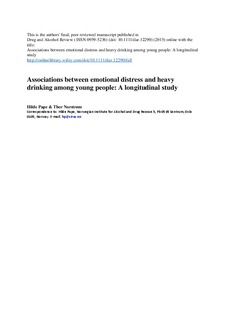Associations between emotional distress and heavy drinking among young people: A longitudinal study
Journal article

Permanent lenke
http://hdl.handle.net/11250/2386263Utgivelsesdato
2015Metadata
Vis full innførselSamlinger
Sammendrag
This study adds to the meagre body of longitudinal research on the link between emotional distress and alcohol use among young people. We address the following research questions: Are symptoms of anxiety and depressed mood likely to be causally related to heavy episodic drinking (HED)? Does the association change as individuals move from adolescence to early adulthood?Data stemmed from a national sample of young people in Norway that was assessed in 1992 (T1; mean age = 14.9 years), 1994 (T2), 1999 (T3) and 2005 (T4) (response rate: 60%, n = 2171). We applied fixed-effects modelling, implying that intra-individual changes in the frequency of HED were regressed on intra-individual changes in emotional distress. Hence, confounding due to stable underlying influences was eliminated. Self-perceived loneliness was included as a time-varying covariate.Emotional distress was unrelated to HED in adolescence (T1 to T2). In the transition from adolescence to early adulthood (T2 to T3), changes in depressiveness were positively and independently associated with changes in HED, whereas changes symptoms of anxiety were not. A similar pattern emerged in early adulthood (T3 to T4).The potential causal relationship between emotional distress and heavy drinking did not manifest itself in adolescence, but increased symptoms of depressiveness were related to more frequent HED in subsequent periods of life. Hence, this study provides conditional support to the notion that emotional distress and HED may be causally related and indicates that the association among young people may be specific to depressiveness.
Beskrivelse
-